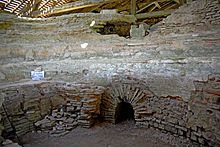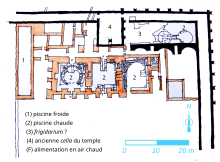
Lycosura was a city in the ancient Parrhasia region of south Arcadia said by Pausanias to be the oldest city in the world, although there is no evidence for its existence before the fourth century BCE. Its current significance is chiefly associated with the sanctuary of the goddess Despoina, which contained a colossal sculptural group that Pausanias wrote was made by Damophon of Messene. This group comprises acrolithic-technique statues of Despoina and Demeter seated on a throne, with statues of Artemis and the Titan Anytos standing on either side of them – all in Pentelic marble. The dates of both the temple and the sculptural group have occasioned some dispute. Remains of a stoa, altars, and other structures have been found at the site as well. The Sanctuary of Despoina at Lycosoura is located 9 km WSW of Megalopolis, 6.9 km SSE of Mount Lykaion, and 160 km SW of Athens. There is a small museum at the archaeological site housing small finds as well as part of the cult group, while the remains of the cult statues of Despoina and Demeter are displayed at the National Archaeological Museum of Athens.

The Temple of Aphaia or Afea is an Ancient Greek temple located within a sanctuary complex dedicated to the goddess Aphaia on the island of Aegina, which lies in the Saronic Gulf. Formerly known as the Temple of Jupiter Panhellenius, the Doric temple is now recognized as having been dedicated to the mother-goddess Aphaia. It was a favourite of Neoclassical and Romantic artists such as J. M. W. Turner. It stands on a c. 160 m peak on the eastern side of the island approximately 13 km east by road from the main port.

In Gallo-Roman religion, Sequana is the goddess of the river Seine, particularly the springs at the source of the Seine. Although the origins of the goddess are Celtic, Sequana was subsequently integrated into a Gallo-Roman regional cult of worship after the Roman conquest of Gaul. The main sites dedicated to her are found in northern Burgundy, especially at the source of the Seine, where archeological excavations have unearthed a temple complex and over a thousand votive offerings.
The archaeological site of Alba-la-Romaine, corresponding to the Gallo-Roman city of Alba Augusta Helviorum or Alba Helviorum is located near the present town of Alba-la-Romaine. The site is in the French department of Ardèche, Rhône-Alpes. During the Roman Imperial era, Alba was the capital of the Celtic-speaking polity of Helvii, which had territory covering the area of lower Vivarais.

A Romano-Celtic temple or fanum is a sub-class of Roman temples which is found in the north-western Celtic provinces of the Roman Empire. It was the centre of worship in Gallo-Roman religion. The architecture of Romano-Celtic temples differs from classical Roman conventions, and archeological evidence demonstrates continuity with pre-Roman Celtic forms. Many temples were built on sites which had been sacred to the Celtic religion before the Roman conquest.
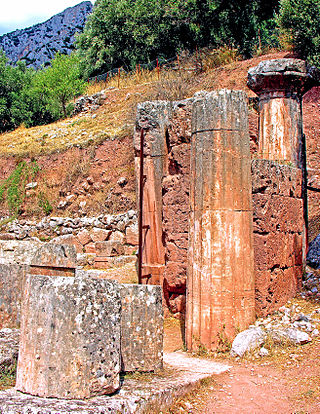
The Temple of Athena Pronaia was a temple at the ancient site of Delphi, in the Sanctuary of Athena Pronaia, a group of buildings comprising temples and treasuries as well as the famous Tholos of Delphi. There were in fact three successive temples built at the site. The earlier temples (38°28′49″N22°30′30″E), referred to as A and B, were built in the 7th and 6th centuries BC respectively and were made of porous stone; a third temple (38°28′49″N22°30′28″E) was built of limestone in the 4th century BC, although it is not certain that it actually was dedicated to Athena this time.
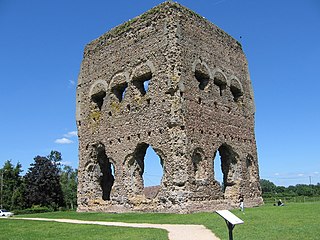
The "Temple of Janus" is a Romano-Celtic religious structure located in Autun, Saône-et-Loire, France, to the North-West of the ancient city of Augustodunum.

The Temple of Mercury at Puy de Dôme is a Gallo-Roman trachyte temple built in the 2nd century at the summit of the lava dome. It replaced a 1st-century arkose temple on the same site, which was apparently too small to accommodate the many pilgrims who visited. Its remains were revealed by excavation campaigns in 1875 and at the turn of the century.
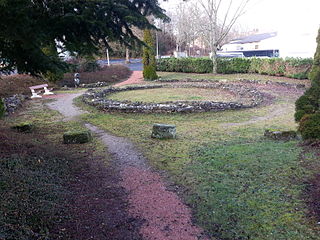
Fanum d'Aron is a fanum, or Romano-Celtic temple, located in Aurillac, a French commune in the Auvergne region.

The Tower of Vesunna is the vestige of a Gallo-Roman fanum (temple) dedicated to Vesunna, a tutelary goddess of the Petrocorii. The sanctuary was built in the 1st or 2nd century. Vesunna was the Gallo-Roman name for Périgueux, in the Dordogne department, in the Nouvelle-Aquitaine region.

The Temple "of Mars" is the vestige of a Romano-Celtic fanum and its courtyard, located in Corseul, in the department of Côtes-d'Armor, France.
The Saint-Martin-au-Val Sanctuary is a monumental Gallo-Roman temple complex still undergoing excavation in Chartres. It is one of the largest sanctuaries from Roman Gaul and is notable for its rare preservation of an ornate wooden ceiling. It featured a cult site to Diana and Apollo.

The Tour de Grisset is the remains of a small, Gallo-Roman temple or fanum located in Fréteval, Loir-et-Cher, France. It is one of the few Gallo-Roman fana to still be standing, and perhaps the only one with its brick vault still in place. Excavations in the 1960s revealed a bath complex and series of other structures at the site, and it has been proposed that a small, secondary agglomeration of structures may also exist there.

The Jublains archeological site is a cluster of ruins, mostly dating back to Ancient Rome, in the current French commune of Jublains in the département of Mayenne in the Pays de la Loire.

The mausoleum of Lanuéjols is a Gallo-Roman funerary monument located in the commune of Lanuéjols, in the French Department of Lozère.
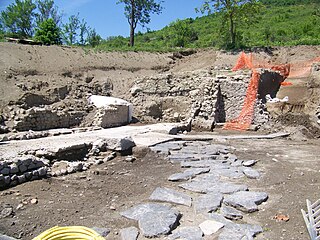
The Trémonteix sanctuary was a Roman sanctuary with a double fanum and a single cella linked to a Roman villa. It was built 2.5 km from the center of the ancient city of Augustonemetum/Clermont-Ferrand, France. Discovered in 2009 during a preventive archaeology study, the villa was excavated between 2010 and 2011, then partially destroyed by the subsequent development work. Only the sanctuary, listed as a historic monument in 2012, has been preserved in a green zone.

Tasciaca was an ancient vicus characterized by a series of Gallo-Roman settlements located in the communes of Thésée, Pouillé, and Monthou-sur-Cher, on either side of the Cher River, in the French department of Loir-et-Cher in the Centre-Val de Loire region.

The pillar of Yzeures-sur-Creuse is an ancient monumental column constructed from Jurassic limestone with shell inclusions. Some remnants were discovered in and near the foundations of the former church of the French commune of Yzeures-sur-Creuse, in Indre-et-Loire in 1895.
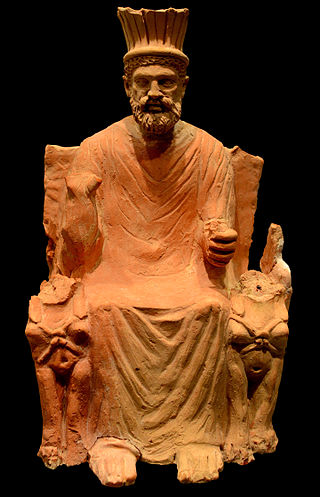
The Sanctuary of Thinissut is an archaeological site located in Tunisia, whose excavation started in the early 20th century. It is situated in the present-day locality of Bir Bouregba in the Cap Bon region, approximately five kilometers from the town of Hammamet and sixty kilometers southeast of the capital, Tunis.

Camille de La Croix was a Belgian Jesuit priest who made significant contributions to both music education and archaeology. He resided in Poitiers, France, from 1864 until his death on April 13, 1911.





